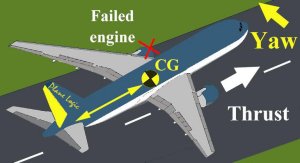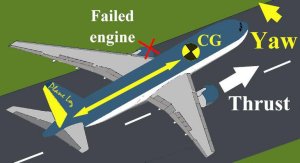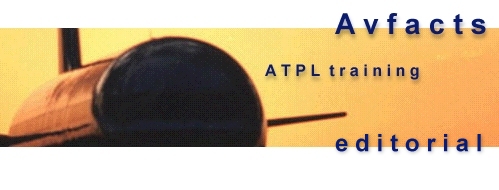| Vmcg
This speed relates to takeoff in a
multi-engine aircraft, and is the abbreviation for “minimum
control indicated airspeed - ground”. It is found with aircraft
flaps and trim in takeoff configuration, critical engine suddenly
failed, most unfavourable C of G (rear), and takeoff power on
remaining engine(s). With thrust set at high values needed for
takeoff, failure of one engine will cause the aircraft to swing
(yaw) toward the dead engine. This is particularly marked when
considering large twin engine aircraft that feature wing mounted
engines, more so than for those aircraft with fuselage mounted
engines, where the engine thrust lines are closer together, and
asymmetrics less of a problem.
Vmcg is the minimum speed at which
the pilot can maintain directional control of the aircraft with one
engine suddenly becoming inoperative during the takeoff roll, with
the use of aerodynamic controls only. Rudder effect is the only
steering control assumed available to counter asymmetric yaw when
finding Vmcg speed for the aircraft type under consideration. It is
assumed the aircraft has just been rotated off the runway when the
engine fails, and the nose wheel is no longer in contact with the
runway, but that the main wheels are still on the ground. Obviously
we would need to ensure we did not rotate the aircraft off the
ground until we had achieved or exceeded Vmcg, otherwise we risk
departing the runway. The larger the rudder surface area and
deflection range available, the greater the ability to counter the
asymmetric yaw at any given speed, and lower Vmcg speed. Larger fin
area will also assist here on both counts. Another consideration
effecting Vmcg is the position of the center of gravity (C of G). A
rearward centre of gravity produces a more adverse yawing couple,
and reduces the leverage force that can be provided by the rudder to
counter the yaw. Conversely, a forward C of G will provide better
yaw control, and a lower Vmcg.
|
|
The thrust setting for takeoff also
has an effect on Vmcg, such that high power settings increase Vmcg
values, as more asymmetric yaw follows an engine failure. De-rated
(low thrust setting) takeoffs reduce the asymmetric yaw, and with it
Vmcg speeds. We would prefer a very low Vmcg speed, as this gives us
greater asymmetric control. See summary of factors that reduce Vmcg
values.
|

Fig 1. Rearward C of G, less leverage, less control. |
Factors that reduce Vmcg values
- Density altitude .
- Reduced thrust takeoff.
- Large tail fin area.
- Large rudder area/large rudder
deflection available.
- Forward C of G.
- Short distance from engine to
fuselage.
|

Fig 2. Forward C of G, greater leverage, more control. |
These texts form part of the ATPL
Performance and Loading course
produced by Rob Avery. It is presently available as a self study course in
paper version, via the internet or on CD ROM,
anywhere in the world. It is focussed on the knowledge required to pass
the CASA ATPL examination. The course includes assignments with answers
provided. More information can be found that Avfacts
web site.

Marty says ... "Goodbye to GA".
|










